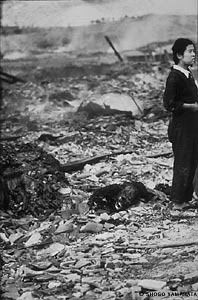Public hearings begin today on nuclear "Bombplex"
Today marks the start of public hearings on the U.S. Department of Energy's $150 billion plans to streamline the nation's current atomic arsenal of some 10,000 warheads -- and to build new nuclear weapons at various sites, including several in the South. The hearings will be held today from 11 a.m. to 3 p.m. and from 6 p.m. to 10 p.m. at the North Augusta Community Center in North Augusta, S.C. Hearings are also scheduled for next week in Oak Ridge, Tenn. and Amarillo, Texas. For a complete schedule, click here [PDF].
 Known by the government as "Nuclear Weapons Complex Transformation," the project aims to consolidate nuclear weapons materials at five sites and to develop the nation's plutonium bomb capability. To grasp the immediate damage a plutonium weapon can cause, see accompanying photo of Nagasaki by Yosuke Yamahata; click on it for more images of that city in the bombing's wake. The U.S. government currently operates eight major nuclear weapons facilities: Los Alamos National Laboratory in New Mexico, Lawrence Livermore National Laboratory in California, Sandia National Laboratories in New Mexico and California, Pantex Plant in Texas, Y-12 National Security Complex in Tennessee, Kansas City Plant in Missouri, the Savannah River Site in South Carolina, and the Nevada Test Site.
Known by the government as "Nuclear Weapons Complex Transformation," the project aims to consolidate nuclear weapons materials at five sites and to develop the nation's plutonium bomb capability. To grasp the immediate damage a plutonium weapon can cause, see accompanying photo of Nagasaki by Yosuke Yamahata; click on it for more images of that city in the bombing's wake. The U.S. government currently operates eight major nuclear weapons facilities: Los Alamos National Laboratory in New Mexico, Lawrence Livermore National Laboratory in California, Sandia National Laboratories in New Mexico and California, Pantex Plant in Texas, Y-12 National Security Complex in Tennessee, Kansas City Plant in Missouri, the Savannah River Site in South Carolina, and the Nevada Test Site.
The proposed project has been dubbed "Bombplex" by its foes, which include Georgia-based Nuclear Watch South. The group is calling instead for atomic disarmament and a "De-Manhattan Project" to develop technologies to safeguard the environment from radioactive contamination, since the deadly effects of nuclear weapons are not always as dramatic as the images from Nagasaki. Groundwater around the Savannah River Site, for example, has been contaminated with tritium and other radioactive and toxic chemicals, and some of that pollution has made its way into the nearby Savannah River. (For more details on the contamination, read "Nuclear Dumps by the Riverside," [PDF] a report by the Maryland-based Institute for Energy and Environmental Research.)
The DOE is currently preparing a final environmental impact statement for the project. The draft EIS declined to consider disarmament as an option, but Nuclear Watch South wants to convince it to do so in the final version. The DOE will be accepting public comments through April 10; they can be submitted by e-mail to complextransformation@nnsa.doe.gov or by regular mail to Theodore A. Wyka, Complex 2030 SEIS Document Manager, U.S. Department of Energy, NA 10.1, 1000 Independence Ave. SW, Washington, DC 20585.
(The photo of a victim and survivor of the plutonium bomb dropped on Nagasaki is by Yosuke Yamahata, from the Web site "Remembering Nagasaki," where more images of the bomb's damage are available.)
Tags
Sue Sturgis
Sue is the former editorial director of Facing South and the Institute for Southern Studies.
